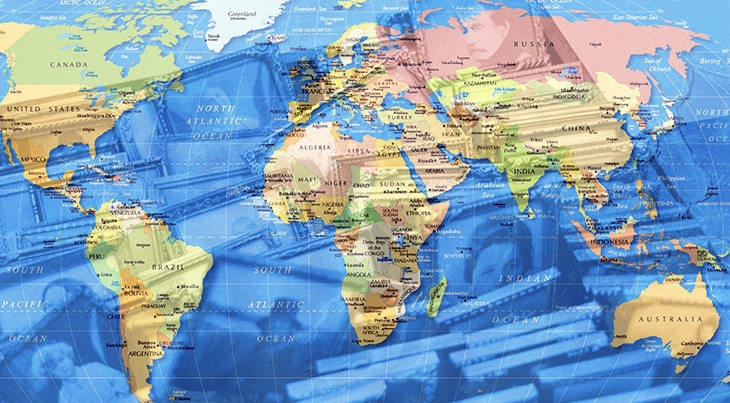Tracing Your Immigrant Ancestors
How to Find Records and Retrace Their Journey to North America
Have you ever wondered where your family came from before arriving in North America? What was your ancestor’s life like in the old country? Where did they work, who did they love, how did they get by? Understanding your heritage can bring their human story to life in vivid detail.
 (Vintage Framed Photos Source: Rach Teo Via Unsplash Blended With World Map: A. Hamilton)
(Vintage Framed Photos Source: Rach Teo Via Unsplash Blended With World Map: A. Hamilton)
According to statistics, over 13% of the US population, and 23% in Canada, are foreign-born. That means tens of millions of Canadians and Americans have immigrant ancestors they can research and learn about. Tracing your lineage back to your immigrant forebears can uncover fascinating details about your family’s unique background.
Step 1: Identify Home Country and Timeframe
The first step is gathering basic biographical facts about more recent immigrant ancestors through documents like birth, marriage and death certificates. Details like birthplace, date of immigration, port of departure, names of family members, and occupation provide the initial clues you need to launch your search into the past.
- What do you already know about your immigrant ancestors? Do you have any family stories, heirlooms, or documents that give clues about where they came from and when they arrived? Old family bibles and diaries can contain small but valuable nuggets.
- Talk to older relatives to preserve family stories before they are lost. Oral histories can provide precious context and anecdotes that official records lack.
- Make a timeline of key dates and details to better understand the sequence of events in your ancestor’s journey. When did they leave their homeland? When did they reach America? Plotting events on a timeline provides perspective.
Step 2: Find Passenger Arrival Records
During the 1800s and the first half of the 1900s, millions of immigrants arrived in America through Ellis Island, Castle Garden, and other ports; in Canada, overseas immigrants usually came through the ports of Halifax and Quebec. Searching passenger list databases online, such as Ancestry’s Immigration & Travel Records, can hopefully help you find manifests listing your ancestors. Arrival records can reveal fascinating details about their journey, from what ship they sailed on to who they traveled with.
- What was it like for your ancestors on the long voyage crossing the ocean? What class did they travel in? Who did they meet along the way? What were conditions like for their class? Steerage passengers endured cramped quarters and illness, while first and second class enjoyed luxuries.
- Look for arrival records from all family members. Your ancestors may have made the journey in stages, with the father arriving first to establish a home before sending for the rest of the family.
- If you have trouble finding passenger lists, try searching by ship manifest instead of your ancestor’s name. Ship records may reveal family members missed in name searches.
Step 3: Search Naturalization and Citizenship Records
After living in North America for several years, immigrants often applied for Canadian or US citizenship through the naturalization process. These naturalization records are a genealogical goldmine, listing their birthplace, family members, occupation, and more. A similar naturalization process for immigrants to Canada also existed. You can search for these records through the USCIS Genealogy Program, FamilySearch Naturalization Records, and Ancestry’s Citizenship & Naturalization Records.
- Becoming a citizen was a major milestone in their Canadian / American story. What can naturalization files tell you about their early years in the new country? How long did it take them to apply for citizenship? What occupation did they list?
- Look for naturalization records from all applicable family members. Your ancestors may have applied at different times based on length of residency requirements.
- If you have trouble finding naturalization files, try searching court records. Many courts that handled naturalization cases have since closed, and files were transferred to regional archives.
Step 4: Look Through Ethnic Newspapers
North America’s ethnic press reported on and advertised to growing immigrant communities. Searching digitized newspapers and publications in your ancestor’s native language can sometimes cover obituaries, local happenings, business advertisements, and other clues. Some resources for finding ethnic newspapers include Chronicling America – Ethnic Newspapers and Ancestry’s Historical Newspapers.
- What was daily life like for immigrants in their enclaves and neighborhoods? Ethnic newspapers provide a window into their world. Obituaries can list relatives still in the homeland. Ads may mention their business.
- Don’t limit your search to big cities. Smaller towns often had foreign language newspapers as well. Papers from less populated areas may yield more results than large metropolitan dailies.
- Try searching ethnic newspapers after your ancestors became citizens too. Naturalization didn’t mean they fully assimilated. Immigrant communities remained close knit.
Step 5: Retrace the Voyage
For a truly immersive ancestral experience, consider traveling to your ancestor’s homeland and villages to walk in their footsteps. Seeing the places they knew so intimately can bring their journey full circle. Some resources for planning a trip to your ancestral homeland include Heritage Travel: Connecting With Your Family’s Past, How to Plan a Genealogy Trip to Connect With Your Roots, and FamilySearch Wiki for Country Research Pages.
- How would it feel to visit your ancestor’s birthplace and visualize them there as a child? Retracing voyages reconnects us with family history.
- Look for family houses, churches, cemeteries, and other sites. Your ancestors likely visited places central to village life. See if local records exist.
- Talk to locals and get their perspective on your family’s hometown. Historical context helps you understand the conditions that drove them to leave.
- Visit the passenger ship departure sites. Stand on the docks where your ancestors set sail for America, contemplating the ocean crossing ahead.
By piecing together records, documents, and family lore, you can reconstruct your immigrant ancestor’s incredible journey to North America. Learning their story helps you understand your own. Discovering your heritage forges a bond across time and distance.

